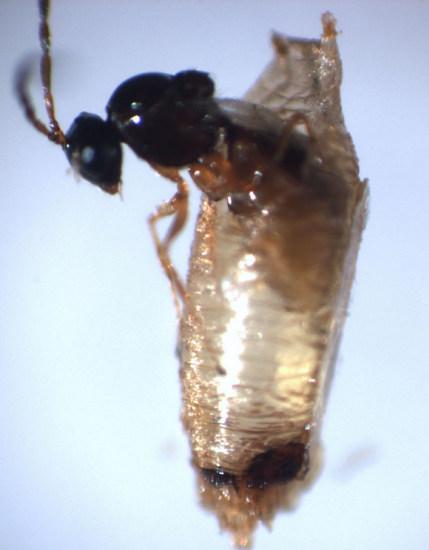
A CCNY-led research team has identified new organelle in parasitic wasp venom.
City College of New York biologist Shubha Govind and her research team have identified the composition of “virus-like particles" (VLPs) found in the venom of a wasp that is a parasite of fruit flies. Invisible to the eye, wasp VLPs suppress the flies’ immune responses by killing their blood cells.
Wasps lay their eggs along with spiked VLP particles into the worm-like immature bodies of Drosophila melanogaster, the long-venerated genetic model of human disease and development. In the wild, parasitic wasps attack insects and are used to naturally control crop damage by insect pests. The Govind lab has developed a model to study this host/parasite interaction in the laboratory. While the particles were originally termed “virus like” due to their size and structure, this work has shifted that view.
The new study reports that VLPs have a profile of “extracellular microvesicles” that are microscopic, membrane-bound transport structures most animal cells use to package and traffic proteins to the outside. Strikingly, VLPs also have proteins that resemble bacterial proteins, found on their needle-shaped “injectisome” used to invade animal cells. The VLP proteins are similarly located on their surfaces/spikes, suggesting parallel mechanisms of invading hosts’ blood cells.
Given the VLP particles’ mixed prokaryotic/eukaryotic properties, the researchers have renamed them MSEVs for “Mixed Strategy Extracellular Vesicles.”
Govind's team included CCNY Division of Science graduate students, Mary Ellen Heavner and Johnny Ramroop, and collaborators Shaneen Singh (Brooklyn College) and Rong Wang (Icahn School of Medicine at Mount Sinai).
The research, which appears in the journal Current Biology, was co-funded by the National Institutes of Health, National Science Foundation, and NASA.
About The City College of New York
Since 1847, The City College of New York has provided low-cost, high-quality education for New Yorkers in a wide variety of disciplines. Today more than 16,000 students pursue undergraduate and graduate degrees in eight professional schools and divisions, driven by significant funded research, creativity and scholarship. Now celebrating its 170th anniversary, CCNY is as diverse, dynamic and visionary as New York City itself. View CCNY Media Kit.